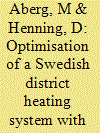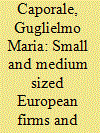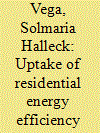|
|
|
Sort Order |
|
|
|
Items / Page
|
|
|
|
|
|
|
| Srl | Item |
| 1 |
ID:
124408


|
|
|
|
|
| Publication |
2013.
|
| Summary/Abstract |
The UK Government's Department for Energy and Climate Change has been investigating the feasibility of developing a national energy efficiency data framework covering both domestic and non-domestic buildings. Working closely with the Energy Saving Trust and energy suppliers, the aim is to develop a data framework to monitor changes in energy efficiency, develop and evaluate programmes and improve information available to consumers. Key applications of the framework are to understand trends in built stock energy use, identify drivers and evaluate the success of different policies. For energy suppliers, it could identify what energy uses are growing, in which sectors and why. This would help with market segmentation and the design of products. For building professionals, it could supplement energy audits and modelling of end-use consumption with real data and support the generation of accurate and comprehensive benchmarks. This paper critically examines the results of the first phase of work to construct a national energy efficiency data-framework for the domestic sector focusing on two specific issues: (a) drivers of domestic energy consumption in terms of the physical nature of the dwellings and socio-economic characteristics of occupants and (b) the impact of energy efficiency measures on energy consumption.
|
|
|
|
|
|
|
|
|
|
|
|
|
|
|
|
| 2 |
ID:
105730


|
|
|
|
|
| Publication |
2011.
|
| Summary/Abstract |
End-use electricity efficiency improvements offer an inexpensive way to reduce power shortages. The present study estimates the potential of demand-side management efficiency improvement targeted at (1) short-term efficiency improvement (agricultural pump rectification) that can provide immediate relief, and (2) long-term efficiency improvement (appliance standards such as AC and refrigerator, new agricultural pump purchase and pump replacement) for Gujarat state in India. The methodology includes the calculation of cost of conserved energy for each technology, which works out to be (-1.18) US$ cents/kW h for new agriculture pump sets, 1.03 US$ cents/kW h for refrigerators and 5.21 US$ cents/kW h for air conditioners. The price of power varies around 1.13 US$ cents to 12.1 cents/kW h in Gujarat. The annual energy savings from the selected energy-efficient technologies are approximately 8767 GW h over a period of 10 yr, while the estimated peak power savings are about 1814 MW, large enough to eliminate one-fourth of the state's electricity shortages. Also, the estimated CO2 emissions savings are about 7715 Giga grams (Gg) from implementation of the selected energy efficiency measures over a period of 10 yr.
|
|
|
|
|
|
|
|
|
|
|
|
|
|
|
|
| 3 |
ID:
110724


|
|
|
|
|
| Publication |
2011.
|
| Summary/Abstract |
The development towards more energy efficient buildings, as well as the expansion of district heating (DH) networks, is generally considered to reduce environmental impact. But the combined effect of these two progressions is more controversial. A reduced heat demand (HD) due to higher energy efficiency in buildings might hamper co-production of electricity and DH. In Sweden, co-produced electricity is normally considered to displace electricity from less efficient European condensing power plants. In this study, a potential HD reduction due to energy efficiency measures in the existing building stock in the Swedish city Linköping is calculated. The impact of HD reduction on heat and electricity production in the Linköping DH system is investigated by using the energy system optimisation model MODEST. Energy efficiency measures in buildings reduce seasonal HD variations. Model results show that HD reductions primarily decrease heat-only production. The electricity-to-heat output ratio for the system is increased for HD reductions up to 30%. Local and global CO2 emissions are reduced. If co-produced electricity replaces electricity from coal-fired condensing power plants, a 20% HD reduction is optimal for decreasing global CO2 emissions in the analysed DH system.
|
|
|
|
|
|
|
|
|
|
|
|
|
|
|
|
| 4 |
ID:
191326


|
|
|
|
|
| Summary/Abstract |
This paper investigates the factors (such as different sources of financing, energy audits and internal monitoring activities) affecting the propensity of European small and medium sized enterprises (SMEs) to adopt energy saving measures (ES). For this purpose, a Probit model is estimated using data from the 2017 Flash Eurobarometer survey covering a large sample of European firms. The analysis is carried out for the full sample as well as for clusters based on an environmental performance index (EPI) and on the level of economic development in turn. The results indicate that internal financing always has a positive effect on a firm's propensity to adopt ES. Private external sources of financing appear to be more important for Western European firms as well as for those located in countries with a greater level of environmental awareness; in the latter, when firms combine private financing with energy audits or internal monitoring activities the propensity to adopt ES increases further. By contrast, in the Eastern Countries this occurs when firms simultaneously rely on public funds and monitoring activities.
|
|
|
|
|
|
|
|
|
|
|
|
|
|
|
|
| 5 |
ID:
103347


|
|
|
|
|
| Publication |
2011.
|
| Summary/Abstract |
In Europe, buildings tend to be equipped with individual air conditioners, which constitute a fast growing electrical end-use. In this context, this study aims to assess the environmental impacts of European individual air conditioners and to analyse policy strategies to reduce these impacts. After analysing the European context concerning individual air conditioners, the environmental impacts of European air conditioners are assessed using a Life Cycle Analysis approach. The following step consists in studying, both technically and economically, different improvement options aiming at reducing the environmental impacts of these appliances. These results, obtained at the product level, are then generalised at the European level and different policy measures are defined and analysed. The main conclusion is that the implementation of a Minimum Energy Performance Standard based on Least Life Cycle Costs could save up to 49 TWh and 20 MtCO2-eq in 2020 and be economically beneficial to the European end-user.
|
|
|
|
|
|
|
|
|
|
|
|
|
|
|
|
| 6 |
ID:
176724


|
|
|
|
|
| Summary/Abstract |
This article explores technology ownership patterns to reveal adoption trends for energy efficiency measures (EEMs) in the Greek residential sector. To do so, we couple observational survey data with discrete choice modeling. Household preferences are revealed through EEMs owned by Greek householders, after having been questioned for a variety of end-use measures and details about their specification. Our results confirm prior evidence on traditional determinants οf technology adoption and extend those by validating that households familiar with information and communication technologies (ICTs) are more likely to own EEMs with smart features. We were also able to highlight the positive influence of participation in subsidy, as well as other support programmes for vulnerable consumers in households’ ownership of EEMs. Our results are then used to simulate the change in technology ownership rates, under no and full participation in a subsidy programme, for three income levels. Simulation outcomes suggest that, for almost all EEMs, the probability for technology ownership is greater for higher-income households benefitting from a subsidy. Nevertheless, the change in the probability of technology ownership due to the subsidy is larger for low- and medium-income households participating in the programme, further encouraging, thus, support for financial policies targeting lower-income households.
|
|
|
|
|
|
|
|
|
|
|
|
|
|
|
|
| 7 |
ID:
183048


|
|
|
|
|
| Summary/Abstract |
Energy efficiency and renewable energy are key pillars of the energy transition, which is high on the policy agenda of governments and organizations around the world in the face of the climate crisis. The Netherlands is underperforming in emissions reduction goals. In this paper, we empirically assess factors to support policy for enhancing the uptake of carbon emissions reduction measures (ERMs) using data from the 2018 release of the Dutch Housing Survey. A distinction is made between owners and tenants, as well as by specific ERMs in the econometric analyses. Besides building features, socioeconomic characteristics and motives, we explicitly address the role of spatial factors. This has received much less attention in the related literature. Local and regional governmental and political conditions can result in spatial variation of uptake in ERMs. Also, differences across the urban-rural gradient, related to the built environment and motivations, can impact uptake. We find that spatial differences matter in the uptake of ERMs, even after controlling for a wide range of individual and building characteristics, which calls for more place-sensitive policies. Insights from this paper are pertinent not only for the Netherlands, but more widely as spatial factors can also be pivotal to take on board in energy policy frameworks in other countries.
|
|
|
|
|
|
|
|
|
|
|
|
|
|
|
|
|
|
|
|
|